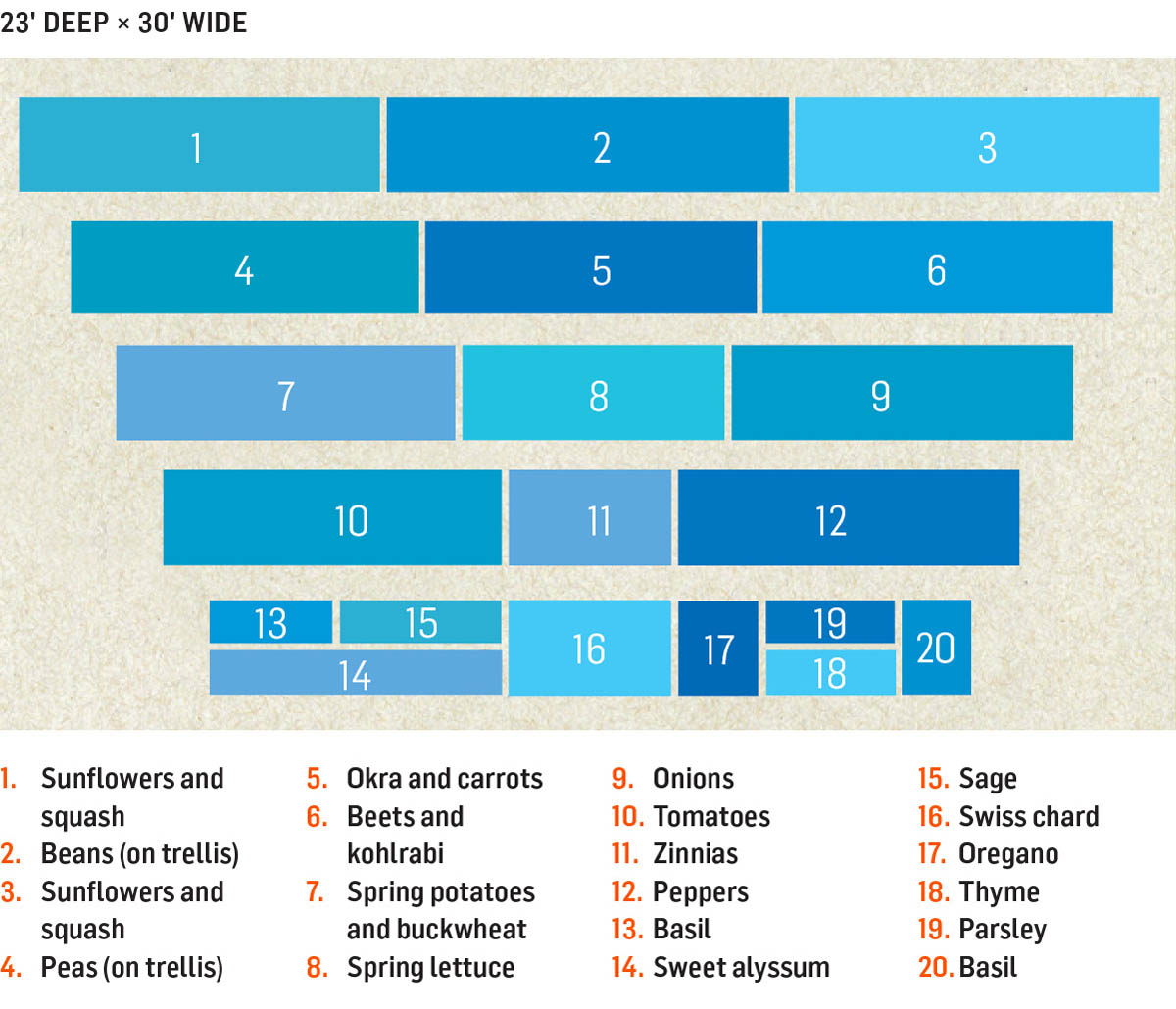
Trying to grow vegetables and other food plants on a sloped piece of land is difficult and potentially dangerous, depending on how steep the slope is. Water runoff erodes the soil and makes trying to keep the garden irrigated a frustrating experience. In her plan, Barbara Pleasant has created inexpensive raised terraced beds to hold the soil and make gardening on a slope easy and enjoyable.
Barbara shows that a hillside which receives plenty of plant-loving sunshine can be transformed into a high-yielding vegetable garden by installing a few simple terraces. In her Zone 6 garden, Barbara used untreated, rough-hewn poplar boards (both cost-effective and locally abundant) and rebar stakes to construct several tiers of terraces. “The boards rot in about four years,” she says, but notes that repairs are easy to do.
A beautiful living tableau. Terracing a slope is a practical way to put unused space into food production, but with good planning and plant choices you can also create a beautiful place. “Visually, a terraced hillside garden sets up like a tableau — envision a chorus line of plants elevated on risers,” says Barbara. “Upright elements exaggerate the stacked effect, so you get double drama from strong verticals like trellised pole beans, sunflowers, and onions.”
In Barbara’s garden, the level 3-foot-wide beds are easy to manage, and routine chores like planting, weeding, and harvesting can be done without walking on the soil. Two-foot-wide pathways allow easy passage for doing garden chores and moving soil amendments onto the beds.

A carpet of clover. To prevent erosion, Barbara recommends mulching the paths or planting a grass-clover mixture, as she does in her own garden. The clippings from this ground cover can then be applied to the garden beds to reduce weeds and keep the soil moist. Plus the clover flowers will help attract pollinating bees and butterflies to the edible plants, boosting yields.
Well-placed herbs. The four largest beds are planted with a blend of vegetables and annual flowers. Barbara saves the bottom plot for culinary herbs. “You don’t want to have to scramble up a slippery hill to get kitchen herbs,” she says, “so they get the most accessible space: Front and center.” Her top herb picks include basil, sage, oregano, thyme, and parsley. The center of the herb bed contains a large clump of Swiss chard, which can be planted in spring and picked continuously until late autumn. Choose a bright-hued variety such as ‘Bright Lights’, ‘Ruby Red’, or ‘Orange Chiffon’ for maximum decorative effect.
Reducing the risk of disease. The vigorous squash plants are placed in the top terrace bed because, as Barbara points out with a laugh, you don’t always know where they want to go. By situating them at either end of that bed, the vines can trail over the edge of the bed and onto the nearby lawn. She likes to group her plant families in one spot, as soilborne diseases can be a problem. “I keep peppers, tomatoes, and eggplants together, for example,” she notes, to simplify the annual rotations that minimize the risk of soilborne diseases. She puts a soaker hose on top of the soil, covering it with a grass-clipping mulch to maintain consistent soil moisture. This simple irrigation system also keeps the leaves of her tomato plants dry, reducing the occurrence of diseases like blight.
To make her space more productive, Barbara relies on succession planting. Here are a few of her suggestions:

1. Sunflowers and squash
2. Beans (on trellis)
3. Sunflowers and squash
4. Peas (on trellis)
5. Okra and carrots
6. Beets and kohlrabi
7. Spring potatoes and buckwheat
8. Spring lettuce
9. Onions
10. Tomatoes
11. Zinnias (nonedible ornamentals for cutting)
12. Peppers
13. Basil
14. Sweet alyssum (nonedible ornamental for pollinators and beneficial insects)
15. Sage
16. Swiss chard
17. Oregano
18. Thyme
19. Parsley
20. Basil